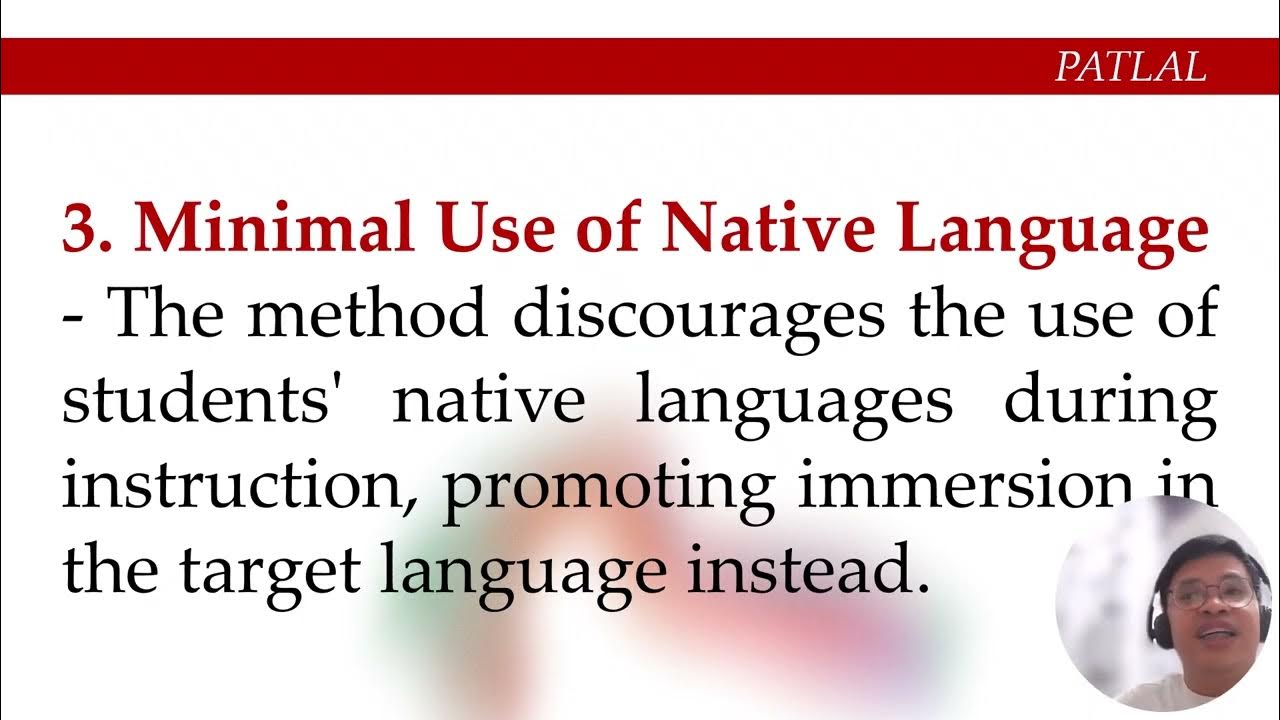Methods and approaches to language teaching (Anthology of videos)
Summary
TLDRThe transcript captures a diverse range of language teaching methods, including the Silent Way, Community Language Learning, Total Physical Response, the Natural Approach, Content-Based Instruction, and the Lexical Approach. It demonstrates activities such as matching words to pictures, role-playing, and using the PPP (Presentation, Practice, Production) model. The script emphasizes the importance of vocabulary, pronunciation, and meaningful communication in language acquisition, showcasing interactive and student-centered approaches to language learning.
Takeaways
- 📚 The Silent Way is a language teaching method developed by Caleb Gattegno, emphasizing student learning through the teacher's silence and use of props.
- 👥 Community Language Learning (CLL) focuses on understanding the whole person, recognizing and accepting the struggles students face as they learn a new language.
- 🏡 A demonstration lesson on fences and gardens illustrates the use of context and real-life scenarios to aid in language pronunciation and vocabulary acquisition.
- 👂 TPR (Total Physical Response) is a method that involves using physical actions to teach language, similar to how children learn their first language through imitation and sensory experience.
- 📈 The Natural Approach, developed by Tracy Terrell and Stephen Krashen, is based on the idea that language should be taught through communication rather than formal grammar instruction.
- 🌐 Content-Based Instruction (CBI) integrates subject matter content with language learning, promoting the use of the target language in a meaningful and authentic context.
- 🔄 The PPP (Presentation, Practice, Production) model is a lesson organization method that progresses from teacher-led instruction to student-centered application of language skills.
- 📘 The Lexical Approach highlights the importance of vocabulary in language learning, suggesting that language is built from lexical items to which grammar is applied.
- 🎭 Role-playing and simulation activities, such as a courtroom scenario, can be used to practice language structures like the present perfect tense in an engaging way.
- 🔍 The Grammar Translation Method is a traditional approach that involves learning vocabulary and grammar rules through reading and translating texts.
- 🔑 Key vocabulary words are crucial for understanding texts, and strategies like guided discovery can help students explore and learn new words in context.
Q & A
What is the Silent Way method in language teaching?
-The Silent Way is an approach to foreign language teaching developed by Caleb Gattegno in the early 1960s. It is unique because the teacher is silent and focuses on the learning of the students, using props and avoiding the use of textbooks.
What does CLL stand for and what is its significance in language learning?
-CLL stands for Community Language Learning. It is a method based on the counseling learning approach to adult education developed by Charles Curran. CLL emphasizes understanding and accepting the struggle students face as they internalize another language.
How does the fence example relate to language learning?
-The fence example is used to illustrate the concept of using everyday objects and situations to teach language. It helps students relate the language to real-life contexts, making it easier to understand and remember.
What is the role of TPR (Total Physical Response) in language learning?
-TPR is a method that involves using physical actions to teach language. It helps students associate language with physical movements, making it easier to remember and understand, especially for beginners.
What is the Natural Approach method in language teaching?
-The Natural Approach, developed by Tracy Terrell and Stephen Krashen, is based on the theory that language should be learned naturally, without the use of the native language in the classroom. It emphasizes exposure to a lot of vocabulary and activities that mimic how a person acquires their first language.
What is the significance of communication in the Natural Approach method?
-In the Natural Approach, communication is the central component of language learning. It focuses on using language in communicative situations without recourse to the native language and without reference to grammatical analysis.
What is Content-Based Instruction (CBI) and how does it differ from traditional language teaching?
-Content-Based Instruction is an educational approach that focuses on teaching academic subjects through the medium of a second language. It differs from traditional language teaching by de-emphasizing grammar in favor of using the language to learn content, which can make learning more interesting and motivating.
What are the advantages of using the PPP (Presentation, Practice, Production) triangle in lesson planning?
-The PPP triangle helps organize lessons into three clear stages: Presentation, Practice, and Production. This method ensures that each stage builds on the previous one, allowing for a logical sequence in teaching and learning.
What is the Lexical Approach in language learning and why is it important?
-The Lexical Approach emphasizes the importance of vocabulary in language learning. It suggests that language consists of lexical items to which grammar is applied, rather than the other way around. This approach recognizes that a solid vocabulary is necessary for effective communication.
How does the Grammar Translation Method differ from other language teaching methods?
-The Grammar Translation Method focuses on learning vocabulary, studying grammar rules, and translating texts from one language to another. It is often used for reading comprehension and does not emphasize speaking or listening skills as much as other methods.
Outlines

This section is available to paid users only. Please upgrade to access this part.
Upgrade NowMindmap

This section is available to paid users only. Please upgrade to access this part.
Upgrade NowKeywords

This section is available to paid users only. Please upgrade to access this part.
Upgrade NowHighlights

This section is available to paid users only. Please upgrade to access this part.
Upgrade NowTranscripts

This section is available to paid users only. Please upgrade to access this part.
Upgrade Now5.0 / 5 (0 votes)





